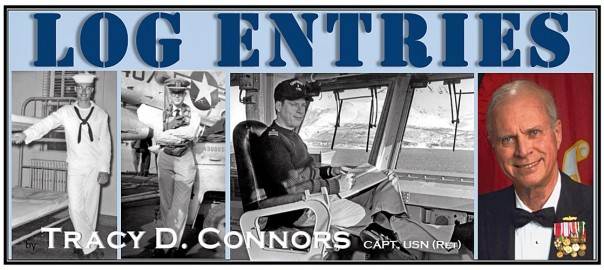There was a click and he was gone.
I start to click, too.
“Boats, sound the fire gong, and 1 bell.”
He sounded the gong which is rapid ringing of the ship’s bell followed by one, two or three rings to show whether the fire is forward, aft or amidships.
DC Central cuts into the 1 MC system and announces, “This is DC Center. The nearest repair locker to the fire is 1B.”
The ship’s fire parties are already speeding to the scene.
“Boats, sound fire quarters, again.”
He does so, and we begin to wait. I notice the Quartermaster now writing furiously in the log book.
Five long minutes pass in silence as we wait for a report from the fire parties and then I see the sound powered telephone talker sit straight up. Obviously, he has gotten some surprising news.
He nods his head as the speaker completes the report than announces, “After brow reports man overboard starboard side.
”Boats, sound man overboard starboard side.”
This isn’t too bad now. We will just send a boat out to pick him up. If we were underway, however, all hands would have to muster immediately to find out who was missing while the ship either turned back to find him, or delegated one of the destroyers to find him.
The telephone rings and the messenger reports to me that the fire is out.
“Boats, sound secure from Fire Quarters.”
He does so on the 1 MC.
“After brow reports,” the sound powered telephone talker reports, “that the man fell off U-boat Number 6 while painting the side. Number 1 U-boat has picked him up and he is being taken to sick bay.”
“Very well. Sound secure from man overboard.”
What a flailex, and it all happened so fast, too. I step back out onto the deck in time to hear the JoD say, “Officer’s boat, loading.”
We get off five officers, and two of the wives. I pick the megaphone up and walk to the side.
“Coxswain, when told to shove off your orders will be to proceed to Fleet Landing, remain there until 13:15 and then return to the ship. Do you under understand your orders?”
“Yes sir!”
“Very well. Shove off and carry out your orders.”
“Aye, aye sir.”
A salute and he heads for Fleet Landing.
The OOD is responsible for all boating and therefore has to give explicit orders to the Coxswains. Also, one must remember that orders can be misunderstood or misinterpreted…directions should be exact.
It had begun to cloud over. The wind was soon very sharp without the sun’s warmth.
I stepped back into the deck hour just in time to receive a report from sick bay concerning Seaman Jones. The Quartermaster entered it in his log, “Jones, E.E., EN3, A Division, 584-49-55, USN, while walking to fleet landing was hit in the face by another Sailor, knocked down upon the sidewalk resulting in multiple abrasions of the face. Treatment, clean face and applied merthiolate: disposition, duty.”
All accidents of any consequence are entered in the ship’s log to prevent individuals in later years from suing the Navy on the grounds of an old injury received while in the Navy. When this happens, the Bureau of Medicine takes the information about the injury from the log which is kept as a permanent legal document and uses this information in court to defend the Navy.
The wind began rising, so I reduced boating to 50 percent capacity. This is a safety measure on my part to help avoid possible risk—to the boat passengers and also to the ship in case the boat were to capsize and loss of life result.
If the wind rises much higher, I’ll cancel boating altogether.
“Sir, the after brow reports that a tug has hit boat boom Number One.”
“Is anyone hurt?”
A pause while he questions the party on the other end of the line, then, “No sir. The boom is not damaged either, but the tug broke off both her forward and after masts.”
“What is the name of the tug?”
Another pause.
“Le Petite.” Well, I thought to myself, she’s now a little more “petite” than she was a few minutes ago.
“What was she doing alongside?”
“Tending barges.”
“Very well, Quartermaster, enter this in the log. Talker, tell the after brow to keep me informed of the tug’s actions.”
“Yes, sir.”
Just after this matter was taken care of, the CDO came down to take a look around and to look at the log. Asked about the Captain and if I had the CO’s absentee pennant flying. I did have, and the log looked good. He left shortly thereafter.
The CDO is above the OOD in authority, being directly appointed by the Captain to supervise the ship. However, the OOD makes most of the decisions and is superceded by the CDO only in an emergency or a case of better judgment by virtue of more experience.
© Tracy D. Connors 2015 All Rights Reserved
